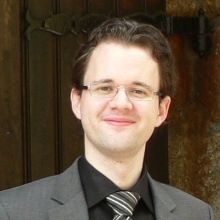Dr. Langer, you have recently habilitated in Mathematics. How was it?
Partly exhausting. Especially the last two weeks before the exam were stressful. But I suppose that's what is wanted.
Why exactly the last two weeks? A habilitation usually takes several years?
You have to know that you can divide the habilitation in two parts. On the one hand the research, which lasts several years and then leads to a habilitation dissertation and on the other hand the habilitation examination, which actually has nothing in common with the habilitation thesis. While research may be exhausting too, I do not find it so stressful, as it is what I enjoy. For the habilitation examination, one has to propose three subject areas, which have nothing to do with ones own research and habilitation topics, to the Habilitation Commission. The final topic is then chosen by the commission, which let you know their choice exactly two weeks before the habilitation examination. And these two weeks you have time to get familiar with this topic and to prepare a lecture about it.
So two weeks and then at full throttle.
Exactly. There is no time left for something else. But you know that there will be a time afterwards. Basically, however, it is the same with every test, with the exception that you already know earlier than two weeks what the topic of the exam is.
As you said, the habilitation consists of two parts. Now to the first part. What was the topic of your habilitation thesis?
The topics of my research and thus the habilitation thesis can be summarized under the title "Numerical Methods for Minimizing Total Variation".
What is the "total variation"?
Put simply, it is a measure of the change (oscillation) of functions, with the adjective "total" indicating a finite change. The function does not have to be continuous, but only locally Lebesque-integrable.
Can you give me an example where the total variation is used?
In image reconstruction meanwhile the total variation has become established. It deals with the reconstruction of noisy or generally disturbed images. Images usually have edges that, for example visually separate objects. The total variation allows to actually preserve these edges in the reconstruction process. That is, the total variation allows discontinuous solutions. This also makes the difficulty of constructing efficient numerical methods. To construct and to theoretically investigate such methods was the topic of my habilitation thesis. To give a concrete application example, where the total variation plays a role: Magnetic Resonance Imaging.
What do you like most about your research topic?
The nice thing about this topic is the combination of applications and theoretical mathematics, mostly functional analysis. Thus, the topic is also very varied. For example, in my research I have dealt with modeling, method development, discretization and implementation.
And you always have pictures that you can show at lectures. Although this was meant to be funny, it makes it easier to explain the problem and the results, and in addition, everyone can imagine something under a picture. The interesting thing about many image reconstruction problems is that the associated models lead to seemingly simple optimization problems. By "seemingly simple" I mean that the objective function is relatively short and easy to understand and often no explicit constraints are needed. However, they are anything but easy, because of the discontinuities already mentioned above, the function spaces over which is minimized, lets say, are unpleasant. In summary, this means having an easy-to-understand problem that is very difficult to solve. And that also makes the appeal of these problems.
How did you come to this topic?
About my doctoral thesis, which I wrote at the Johannes Kepler University Linz. There I have already dealt with issues around the total variation and image reconstruction. Since then, this topic has not let me go. Although I have been dealing with this topic for many years now, I always find practice-relevant questions in connection with the total variation that are still unsolved.
Can you give an example for this?
Yes of course. Optimization problems that arise in image reconstruction often consist of a data term, a total variation term and a parameter indicating the importance of this two terms. Research in recent years has shown that this parameter should be locally varying (in the image area). However, up to date it is not clear how an optimal locally varying parameter can generally be obtained automatically. There is a lot going on in this direction right now.
Together with Prof. Bernd Flemisch you are leading the SimTech project "Data-driven optimization algorithms for local dynamic model adaptivity". What is this project about and how does it fit into your previous research?
The aim of this project is to develop and analyze a data-driven, optimization-based adaptive model for gas storage and construct solution methods for it. I have already dealt with adaptive models and optimization problems in connection with image reconstruction problems. I admit, that this project has nothing to do with image processing. Leaving known terrain is also something which makes the attraction of this project. By contrast, Bernd is an expert on fluid and transport processes, as we look at them here. Therefore, we complement each other very well in this interdisciplinary project. In this sense, this project fits perfectly into my research profile.
Thank you for the interview.
Thank you for your interest!
Dr. Andreas Langer
Institute of Applied Analysis and Numerical Simulation
Numerical Mathematics for High Performance Computing


